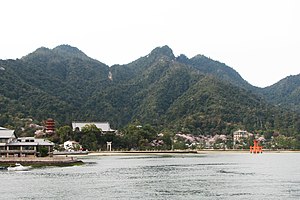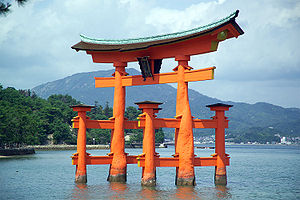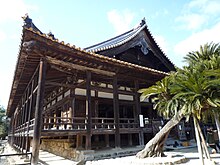Miyajima
| Miyajima | ||
|---|---|---|
| Miyajima with Mount Misen | ||
| Waters | Aki-nada, Seto Inland Sea | |
| Geographical location | 34 ° 16 '31 " N , 132 ° 18' 28" E | |
|
|
||
| surface | 30.33 km² | |
| Highest elevation | Misen 535 m |
|
| Torii in front of Itsukushima Shrine | ||
Miyajima ( Japanese 宮 島 , literally: “Shrine Island”; actual name: 厳 島 , Itsukushima ) is an island in Japan and, according to the Confucian scholar Hayashi Razan , is one of the three most beautiful landscapes in Japan, along with Amanohashidate and Matsushima .
The 30.33 km² island is located about twenty kilometers southwest of Hiroshima , just off the coast of Honshū in the Seto Inland Sea . It can be reached directly from Hiroshima by passenger boats. In addition, there is a ferry connection from Miyajimaguchi several times an hour , with which the residents' vehicles also cross.
On Miyajima was the community Miyajima ( 宮 島 町 - chō ) with about 2,000 inhabitants, which became part of the city of Hatsukaichi on November 3, 2005 together with the island .
Tame game roams freely on the island . The Misen mountain in the middle of the island is known for its Japanese macaques , which move freely between visitors, especially at the mountain station of the cable car.
A typical souvenir of the island are wooden rice spoons ( Shamoji ). Culinary specialties are grilled oysters and maple leaf-shaped biscuits filled with red bean paste .
history
The island was already considered a sacred place in early historical times.
In the past, births and deaths were not allowed on Itsukushima, as both were considered a state of impurity, and the dead are still being brought from the island to the main island of Honshu. Women have only been allowed to enter Miyajima since the 20th century.
Itsukushima shrine
The basic shape of the shrine was created in 593. The structure that is still preserved today was built in the 12th century for Taira no Kiyomori .
The main buildings of Itsukushima Shrine rest directly in front of the island on raised platforms, the pillars of which are in the water at high tide, so that the whole complex appears to be floating. They are connected to one another by a 280 meter long covered corridor.
Part of the shrine is the oldest surviving Nō stage in the world, consisting of a roofed stage and a building for the actors connected to it by a bridge.
The wooden torii from 1875, which stands about 160 meters in front of the shrine, is world famous. At low tide it can be reached on foot, at high tide it is completely in the water. It is one of the most photographed landmarks in Japan.
The shrine and torii were declared a World Heritage Site by UNESCO in 1996 .
In early September 2004 a violent typhoon destroyed a large part of the shrine complex, but the buildings were quickly rebuilt.
The shrine is one of the most desirable (and expensive) locations for traditional Japanese weddings. In rare cases, traditional ceremonial dances ( kagura ) are performed with the accompaniment of traditional instruments.
Mount Misen
The 535 meter high mountain Misen ( 弥 山 Misen ) in the center of the island is completely covered with forest, below the north side of the mountain there is even primeval forest. A cable car leads to the summit, but the mountain can also be climbed on a steep path from the Daishō-in ( 大聖 院 ) temple .
The Buddhist monk Kūkai (also known as Kōbō-Daishi), who allegedly retired there in the fall of 806 for 100 days for ascetic exercises, is considered to be the first colonizer of Misen Mountain . The fire he ignited is said to have never been extinguished since then and is now burning in the “Hall of the Fire that never goes out” ( 不消 霊 火 堂 , Kiezu no Reika-dō ) below the summit. It is also the origin of the flame in the Hiroshima Peace Memorial Park for the victims of the atomic bombing.
In honor of the three mountain gods of the mountain, a fire run is carried out every year in mid-April and mid-November , during which the believers run over coals ignited by the eternal fire.
Senjō-kaku
In 1587, Toyotomi Hideyoshi ordered this hall to be built so that Buddhist sutras were chanted here every month to comfort the souls of those who had fallen in war. When Hideyoshi died in 1598, the building was not yet finished; walls and ceilings were missing. The actual name of this hall is Toyokuni Shrine ( 豊 国 神社 , Toyokuni-jinja ), so named in 1872 and dedicated to Hideyoshi's soul; but in general it is called Senjō-kaku ( 千 畳 閣 ), "Tower of a thousand tatamis", an allusion to the size of the hall, which is built from massive wooden beams and pillars.
Next to the hall is a five-story pagoda , which is striking because of its strong orange-red color. It also belongs to the Itsukushima Shrine. The special feature of this pagoda is the central support beam, which only extends from the top to the first floor. There are said to be five pagodas of this type in Japan.
Web links
- Miyajima Official Site - Japanese, English, Korean, French, Chinese, and German
- Declaration of admission by UNESCO to the World Heritage Site - English
- Detailed information on Miyajima ( Memento from July 15, 2010 in the Internet Archive )
Individual evidence
- ↑ 島 面積 . (PDF; 136 kB) (No longer available online.) Kokudo Chiriin , October 1, 2015, archived from the original on June 15, 2016 ; Retrieved August 2, 2016 (Japanese). Info: The archive link was inserted automatically and has not yet been checked. Please check the original and archive link according to the instructions and then remove this notice.




